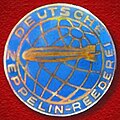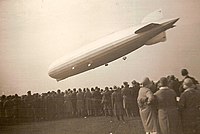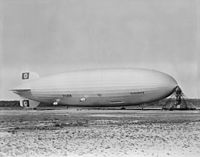Deutsche Zeppelin-Reederei
Zeppelin Luftschifftechnik | |
| Headquarters | Friedrichshafen, Germany |
|---|---|
| Website | http://www.zeppelinflug.de |
 | |||||||
| |||||||
| Founded | 22 March 1935 | ||||||
|---|---|---|---|---|---|---|---|
| Ceased operations | 20 August 1939 | ||||||
| Fleet size | 3 | ||||||
| Destinations | Ernst Lehmann , CEO | ||||||
Deutsche Zeppelin-Reederei (lit. 'German Zeppelin Transport Company'), abbreviated DZR, is a German
In the mid-1930s, the DZR was a commercial airline based in Frankfurt that operated zeppelins in regular transatlantic revenue service, including the famous LZ 129 Hindenburg. Following the Hindenburg disaster in 1937 the DZR stopped transatlantic service, although it launched a new airship in 1938 and had another on order. Plans for more operations ended at the outbreak of World War II and its remaining two zeppelins were dismantled and scrapped in 1940. Today's DZR sees itself as the successor of this original airline and is incorporated under the same name.[3]
History
DELAG (1909–1935)
DELAG (German: Deutsche Luftschiffahrts-Aktiengesellschaft; English: German Airship Transportation Corporation Ltd) was founded on 16 November 1909 as a subsidiary of the Luftschiffbau Zeppelin Corporation to commercialize airship travel. It became the world's first passenger airline in revenue service with the launch of LZ 7 Deutschland in 1910.[4] While DELAG's initial flights were primarily sightseeing tours, by 1919 it was operating a regular schedule between Berlin and Friedrichshafen with a stop at Munich. Between 1910 and the outbreak of World War I DELAG transported over 34,028 passengers on 1,588 commercial flights.[5]
The first DZR (1935–1940)

Founding
The creation of the DZR as successor to DELAG occurred for both political and business reasons.
Deutsche Zeppelin-Reederei was therefore incorporated on 22 March 1935 as a joint venture between
| DZR shareholders, 1935 | Reichsmark (millions) |
|---|---|
| Luftschiffbau Zeppelin GmbH (LZ Group) | 5.7 |
| Deutsche Lufthansa AG (DLH) | 0.4 |
| Reichsluftfahrtministerium (RLM) *shares held in trust by DLH |
3.45 |
| Total capital | 9.55 |
The first
Early success (1935–1937)

The DZR took over the
Hindenburg disaster (1937)
On 6 May 1937 the
The obvious solution was to switch the Zeppelins' lifting gas from highly flammable
Last operations (1938–1939)
The
The new DZR (2001–present)
Deutsche Zeppelin-Reederei GmbH (DZR) was re-established in January 2001 as a direct descendant of the original airline.[7][19] The first Zeppelin NT (SN 01), a prototype registered as D-LZFN Friedrichshafen, flew a series of demonstration flights for the DZR. On 2 June 2001 it carried collector's mail, the first airship postal flight in over 70 years.[20]
The first production
On 8 February 2003 the second production NT airship (SN 03), registered as D-LZZF Baden-Württemberg, was certified for passenger flight. In June 2003 the DZR flew to Thuringia for the first time and in July it visited the city of Bad Homburg 90 years after the first imperial airship stopped there in 1913. In October the DZR added new scheduled destinations: Ravensburg, Salem and Neuschwanstein Castle.[20]
In May 2003 the DZR was certified for operations under
DZR fleet
| Ship | Registration | Class | Year built | Years of DZR service |
Notes | Image |
|---|---|---|---|---|---|---|
| Graf Zeppelin | D-LZ 127 | Graf Zeppelin | 1928 | 1935–1937 | The first aircraft in history to fly over 1 million miles.[22] Grounded 8 May 1937 following the Hindenburg disaster, scrapped March 1940. |

|
| Hindenburg | D-LZ 129 | Hindenburg | 1936 | 1936–1937 | 35 transatlantic crossings, 63 total flights. Destroyed 6 May 1937. |

|
Graf Zeppelin II |
D-LZ 130 | Hindenburg | 1938 | 1938–1939 | 30 demonstration, mail and propaganda flights around Europe. No paying passengers. Scrapped May, 1940. |

|
| Friedrichshafen | D-LZFN | Zeppelin NT N07-100 | 1997 | 2001–2007 | Prototype, pilot trainer, promotions, charter. Transferred to Africa in 2005, damaged by a tornado in 2007, dismantled.[23] [24] |

|
| Bodensee | D-LZZR | Zeppelin NT N07-100 | 2001 | 2001–2004 2012–present |
Sold to Japan 2004, sold back to DZR 2011. Rebuilt as -101. Call sign changed to D-LZFN In service[20] |

|
| Baden-Württemberg | D-LZZF | Zeppelin NT N07-100 | 2003 | 2003–present | Out of service, dismantled.[20] | 
|
| Eureka | D-LZNT | Zeppelin NT N07-100 | 2008 | 2008–2012 | Optioned to Airship ventures. Grounded 2012, disassembled. Rebuilt as -101 in 2019, in service with DZR[25] | 
|
See also
References
- ISBN 978-3-640-599240. p. 6
- ^ DZR Routes and Schedule Archived 2012-07-09 at the Wayback Machine, (in English) retrieved 30-June-2012
- ^ Summary of the Deutsche Zeppelin-Reederei GmbH Archived 2012-07-02 at the Wayback Machine, 2011, retrieved 30-June-2012
- ^ Dan Grossman: "DELAG: The World’s First Airline", November 16, 2009 at airships.net retrieved June 30, 2012.
- ^ Hans von Schiller: Zeppelin, Wegbereiter des Weltluftverkehrs. Kirschbaum Verlag, Bad Godesberg 1966.
- ISBN 978-0801886348. pp. 186–7
- ^ a b c d Dan Grossman: "Deutsche Zeppelin-Reederei (DZR)", 25 January 2010 at airships.net, retrieved June 30, 2012.
- ISBN 3-540-21170-5
- ISBN 978-1-570719745. p 2.
- ^ Syon, p. 188
- ^ A.C. Bergmann: CargoLifter: Wie alles begann, Berlin, 2001. p 59.
- ^ ISBN 3-926162-79-1.
- ISBN 3-926162-55-4
- ^ Anne MacGregor: "The Hindenburg Disaster: Probable Cause" (Documentary film). Moondance Films/Discovery Channel Broadcast air date: 2001.
- ISBN 978-0-231076289. pp 409–410
- ISBN 978-0-060891411. p 131-2
- ^ Syon, p. 200
- ^ Syon, p. 202
- ISBN 978-0-787288815. pp. 39–40
- ^ a b c d e f History of the Zeppelin NT Archived 2012-11-07 at the Wayback Machine, Zeppelin Luftschifftechnik GmbH & CO KG GmbH, 2011
- ^ Erste Teile für neuen Zeppelin NT montiert Archived 2012-10-20 at the Wayback Machine, Press release from the DZR (in German), 13 July 2011
- ISBN 0-8493-5838-8. p 2.
- ^ The D-LZZF Friedrichshafen at airliners.net, retrieved June 30, 2012.
- ^ "Picture of the Zeppelin LZ N07-100 Airship aircraft". Retrieved February 19, 2012.
- ^ Airship Ventures has ceased Flight Operations, Air Ship Ventures, 14 November 2012.
